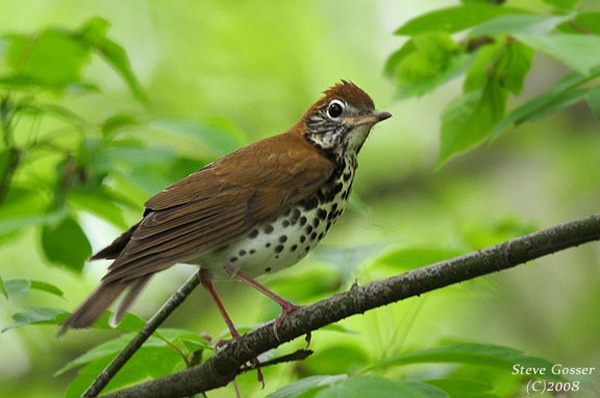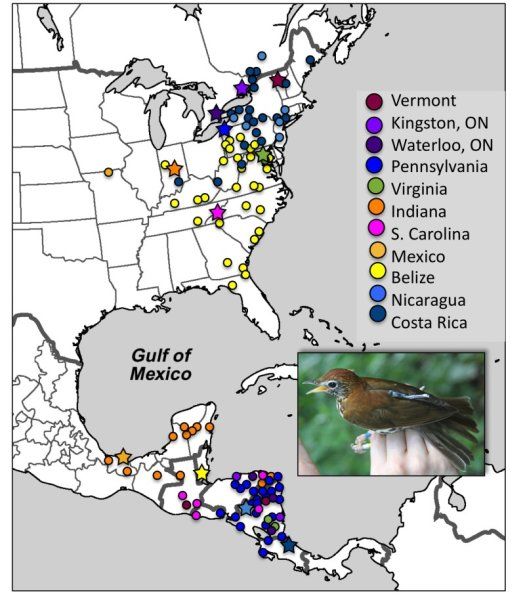
9 June 2015
Though you may not have noticed, wood thrushes aren’t as plentiful as they used to be. According to the Second Atlas of Breeding Birds in Pennsylvania, “they are down by almost half since 1966 … though they remain widespread.”
The change is due to loss of breeding habitat (suburban sprawl for instance), acid rain (which affects their breeding success), and an interesting fact we learned a few years ago.
A team from the York University, Toronto, Canada headed by Bridget Stutchbury has conducted a long term study of wood thrush migration. Using geolocators they’ve tagged wood thrushes on both their breeding and wintering grounds to find out where the birds go and how long it takes them to get there. In 2009 they reported that wood thrushes take their time going south but are quick to return in the spring taking only two weeks to get ‘home.’
The data also revealed that regional populations of wood thrushes stick together on both their wintering and breeding grounds. Birds that breed in Crawford and Erie Counties, Pennsylvania spend the winter together in a small section of eastern Honduras and Nicaragua. Birds that breed in Vermont spend the winter at one location in Nicaragua. The map below from the study’s press release shows a star for each tagging site and round circles for the birds’ destinations. Notice that Pittsburgh’s birds spend the winter in Belize.

From: Connectivity of Wood Thrush Breeding, Wintering, and Migration Sites Based on Range-Wide Tracking. Conservation Biology, 2014
Credit: Image courtesy of York University
Now that we know where the wood thrushes go it’s easier to find out what’s happened. If the one place your region’s wood thrushes spend the winter is logged, fewer will survive to return in the spring.
That’s how deforestation in Central America affects your wood thrush.
Check the maps for yourself on page 9 of the study –> here.
p.s. for Louisiana: This study also found that in the spring all wood thrushes cross the Gulf of Mexico and land at one specific spot near New Orleans. If that spot goes bad, it’s bad news for wood thrushes!
(credits: Wood thrush photo by Steve Gosser, map courtesy of York University press release via Science Daily)
Thank you, Kate. The wood thrush sings my favorite song.
I so look forward to hearing the first wood thrush every spring that I gave up coffee (COFFEE!!) a year ago after learning that deforestation for coffee plantations is a major cause of songbird decline, destroying or drastically altering their winter habitats.
Unfortunately, now I’m learning that abstaining from my morning mug won’t help “my” wood thrushes. In Belize, the major crop-causes of deforestation are bananas, citrus, sugarcane, and shrimp and tilapia farming.
I found this fact and other information at this website: http://tropicalconservationscience.mongabay.com/content/v1/08-03-03-Young.htm
Plenty of sobering info, such as, “If current rates continue unabated, the forest cover will decrease to 58% by 2020 [8] and will be gone within the next 40 years.”
Maybe it’s time to cut out bananas too…
I think the birds going to Belize spill into northeastern Guatemala, too. I saw many wood thrush at ARCAS (near Flores) and at Tikal. When I realized that a Belizian bird guide I met would never have heard the thrush singing, I played the song from my Sibley’s guide on my iPhone, and he was totally amazed at the little spotted brown bird’s beautiful voice.
I hear two singers of these lovely songs every spring and summer, and as of today I have actually seen the singer ONCE. Very shy. But such wonderful singers.